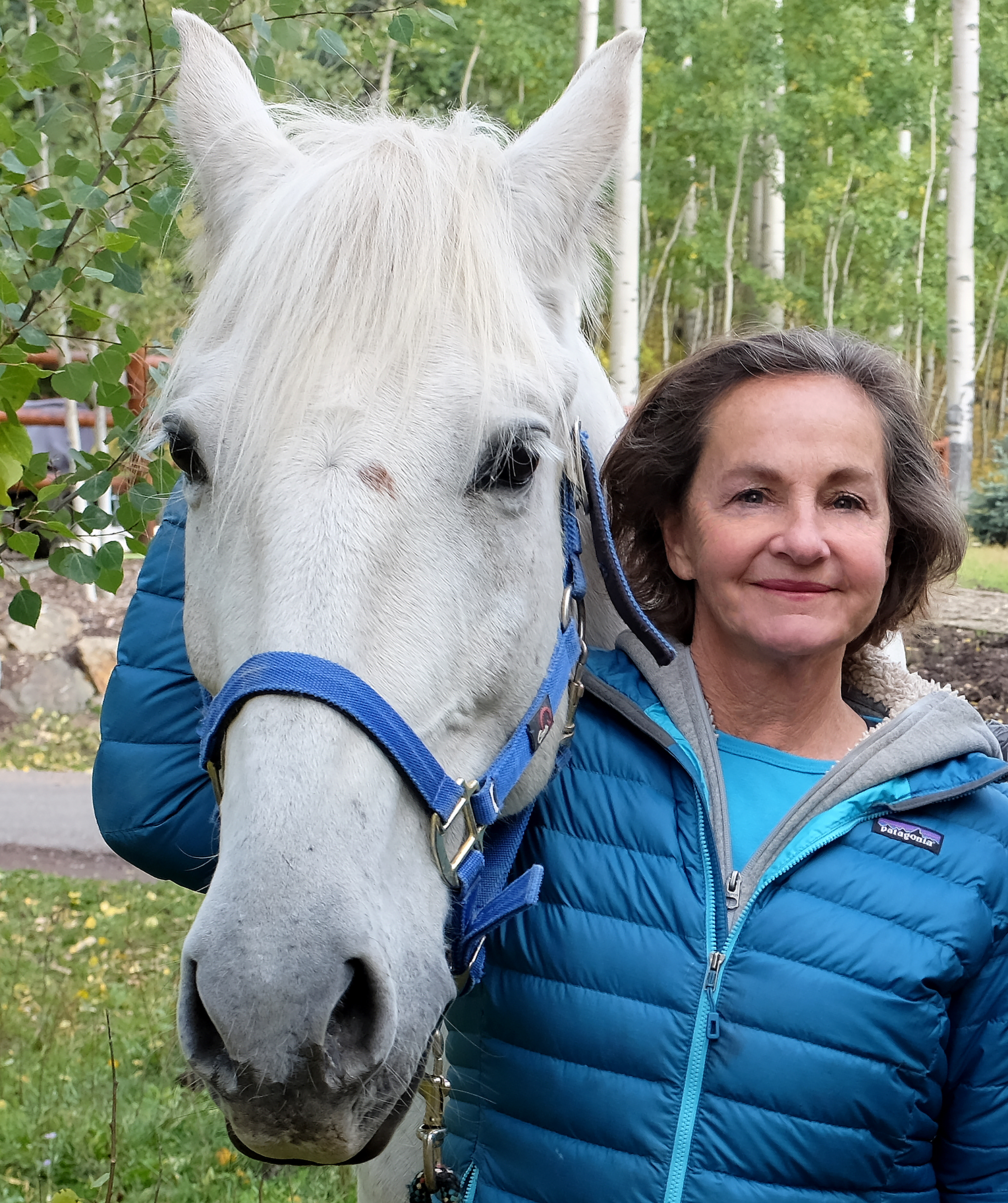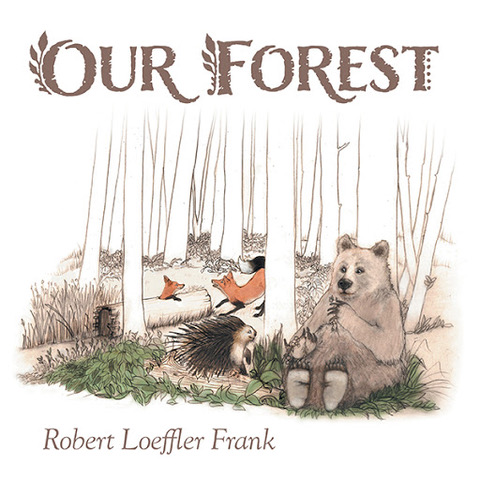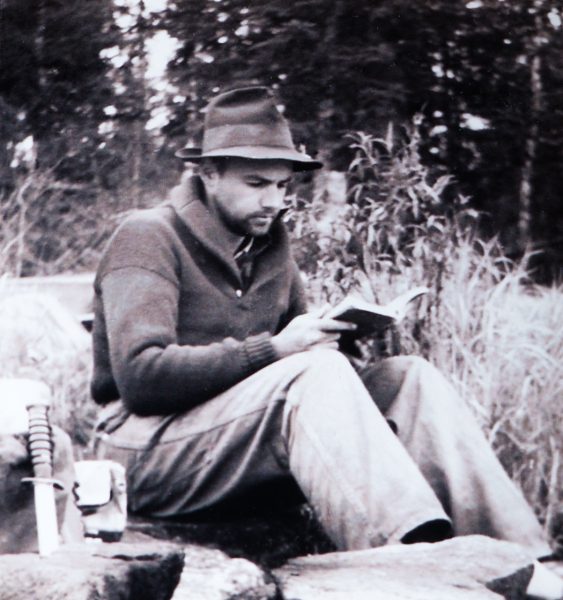
14 Dec Between the Covers: Nancy B. Frank Gets “Up Close & Personal,”12/20
Telluride’s Between the Covers bookstore hosts author Nancy B. Frank, who has recently published two books. Her own, “Up Close and Personal,” features the author’s equine images. Her father’s children’s book is titled “Our Forest.” Early reviews of both works have been raves. The book-signing takes place Thursday, December 20, 5 – 6 p.m.

Out of sight, out of mind. That is until the day you finally get around to doing your spring cleaning.
A. A. Milne, author of the Winnie-the-Pooh series, summed up best: “One of the advantages of being disorderly is that one is constantly making exciting discoveries.”
Like the stories written in poem form by her deceased father, which Nancy B. Frank discovered in a fury of house-cleaning hidden away in a folder in a filing cabinet, long ago put away.
Nancy B. had not realized the stories, vivid in her memory, had actually been transcribed. With great pride she honored her father by publishing his tales.
Robert Loeffler Frank’s manuscript morphed into “Our Forest,” a story about the importance of cooperation and friendship, and one of two books featured at a book-signing on Thursday, December 20, 5 – 6 p.m. at Telluride’s indie bookstore, Between the Covers. The other work being promoted that evening is Nancy’s own “Up Close and Personal,” which showcases her equine paintings. The images explore the sometimes troubled, sometimes harmonious, relationship between horse and human. The author also delves into her own artistic journey and some of her many relationships with horses she has known and loved.

Nancy and Silver.
“The artist drills down to the sensitive and intelligent proclivities of a powerful companion. Her unflinching attention to the gritty detail of tack portrays the heart of a compassionate and responsive owner, rider and artist.” wrote Anne Bachner, author, “Prairie Legacy.”
“‘We aren’t here for a long time, we’re here for a good time.’ Those are Nancy B. Frank’s words to live by. After 13 years living in New York City, Frank chased her dream to ‘play horse’ and moved to a small mountain town in Colorado. Here, she renewed her passion for painting, combining it with an insatiable desire to convey the movement of the horse in two-dimensions. Her paintings sweat, bend, and froth. Moments of flight are frozen; tails are in mid-swing, foamy white saliva sprays, and muscles flex. For Frank, the San Juan mountains serve as the perfect place for her studio, set amidst soaring aspen trees and the sounds of hoofbeats,” said Kelly Woods, Director, Marianne Boesky Gallery.
“Frank’s horses are powerful creatures, beautifully articulated, sensually brushed. Dignity and intelligence shine through their soulful eyes. Her larger-than-life images don’t just rinse the eye either: we are treated to a full bath,” raved Telluride Inside… and Out.
Told in fun rhyming verse and detailed with beautiful illustrations, “Our Forest” delves into the lives of four woodland friends as they work together to overcome problems they encounter. First on the scene is the unlikely duo of Clarence the Bear and Porky the Porcupine, who tackle the daunting challenge of obtaining salt and honey. Reynold and Gerald, a cunning pair of foxes who can barely be told apart, devise a scheme to overcome the pack of hunting dogs that are after them.

Kirkus Media, a notoriously tough critic, has this to say about Robert Loeffler Frank’s “Our Forest”:
“This posthumously published picture book offers readers a rhyming romp through the woods.
“..This book seems made to be read aloud, as it’s written in well-timed, descriptive verse: ‘The atmosphere is hushed and dark, / A jungle made of leaves and bark.’ Reynold’s and Gerald’s names both evoke the fabled Reynard the fox—a clever tidbit that lovers of folktales will undoubtedly appreciate. The pleasant poems are punctuated with gentle, earth-toned, uncredited illustrations of the animals and their surroundings, lovingly rendered in a careful stylistic balance between realism and cartoonish fun. Overall, the book shows a clear respect for nature, nodding to humanity’s relationship with the outdoors in a preface poem.
“An excellent addition to any young nature lover’s library.”
Janet Layberry, editor, Friesen Press, also had high praise for the book:
“Writing complicated stories in rhyme is very difficult. Robert Loeffler Frank’s rhymes are fluid and organic, never sacrificing the narrative flow or logic for the sake of sticking to a pre-conceived rhyming scheme. Instead, his stories and descriptions seem to flow organically within the framework of the rhyme, and are just as readable (if not more so) as a story told in straight prose. He manages to make what are actually fairly complicated rhymes seem simple, and has a wonderful instinct for knowing where line breaks should be, and how narrative poetry needs to work, on a fundamental level. It seems to beg to be read aloud, and I admit to giving in to that urging, simply for pleasure’s sake. This is an incredibly rare thing,”
More about Robert Loeffler Frank (in the words of Nancy B. Frank):

My dad was an organic chemist, a scientist whose hobby was writing sonnets, because of their rigid format. He was a professor of chemistry at the University of Illinois while also participating in the developing synthetic rubber program during the years of WW II. It was there the professor met the undergrad who became my mother. They married in the fall of 1943 after her spring graduation. She was heard to cleverly remark, “I got my PhD before my B.A.!” Eventually Dad left Academia to head up a research laboratory for Morton Salt.
An avid outdoorsman, Dad enjoyed skiing, camping, canoeing and birdwatching as well as racing scow sailboats. He was President of the Outing Club at his alma mater, Dartmouth College. Another of his hobbies was raising Tamworth pigs that he named after all my mother’s relatives. I attribute my love of animals to my father.
Because of his love of the outdoors and wild animals, my father created his own children’s stories. One was a particular favorite; “Carrot Red Top”, a parody on Little Red Riding Hood. Carrot Red Top and her grandmother filled eggs full of hot spices and chili peppers and hot mustard and nails for the Big Bad Wolf to eat. In the telling my serious father would loudly barf, choke, and gag, much to the glee and giggling of his two little daughters, my sister and me.
Books were precious to my father. His den was lined with bookshelves full of books. Whenever I had a school project, my father would invite me into his den to stimulate my imagination with supplemental facts and figures.
I remember when I thought I had been a “bad” girl. I was sent to my room to put my pajamas on and get ready for bed. Because I thought I was in big trouble, I put a copy of the book Black Beauty into my pajama bottoms to protect me from a possible spanking! When my dad realized I had a book in my pants he laughed so hard any punishment was forgotten.
To my amazement, I recently discovered two of his children’s stories in a file long put away, written in poem form. This book is a dedication to my father.
More about Nancy B. Frank:

Nancy and her dog Loeffler, named after her dad, who triggered her love of animals.
When she was a girl, Frank did not just love horses, she thought she was a horse.
“My best friend Peggy and I galloped around my dining room table on our hands and knees. We galloped with scarves sticking out of our pants to look like tails.”
The artist – who holds an M.F.A. in photo-printmaking at the University of Wisconsin-Madison and a B.F.A. in painting at Ohio Wesleyan University – has lived in Telluride since 1989.
Out of the gate, Frank worked successfully in a variety of mediums: jewelry, sculptured cakes, painted furniture, and photography. In fact, her whimsical, over-the-top cakes landed her a feature in The New Yorker.
Back then, however, when she painted, Frank’s subject matter was, frankly, all across the metaphorical map: planets, pearls, birds, and bats galore. While decorative and technically proficient, these early works amounted to lots of hustle, no flow.
And despite her childhood passion for equines, fact is Frank had routinely shied away from horses as a suitable subject matter.
Why?
Horse painting has a long and storied history: just think about the Parthenon frieze; the equestrian portraits of Verrochio and Donatello; the regal equines of Peter Paul Rubens; Degas’s horses at the racetrack; and Picasso’s “Guernica.” And, in the 18th century, the aforementioned Stubbs (1724-1806) became the go-to guy when it came to horse images. (To this this day, the man is widely considered the best horse painter who ever lived.)
Frank knew that history, but had swallowed the standard rap on horse and “sporting” art in general: holier-than-thou critics, even other painters, have historically looked down on animaliers, those who painted only animals, as minor artists who produced work for the amusement of the leisure class only. That was true even in the 18th century, the Age of the Horse.
“So many people like me love the power and grace of a horse, but for years I felt trying to capture that majesty on canvas was such a cliche.”
Those feelings changed when Frank began doing equestrian travel to different countries and cultures. Because of digital photography, she was able to paint from her original color photographs. Frank found herself painting horses, amen, now from the strength of her photographer’s eye and the heart of a person who loves them.
Frank never liked empty spaces on canvas, so she photographed her horses to fill the screen and, subsequently, the picture plane, with haunches and heads, manes and tails, glossy coats, bits, and reins in extreme close-up.
And in doing what she does in the unique way she does it, Frank reigns supreme: her horse images are fraught with the dynamic tension embodied by these powerful, proud creatures, bound up with tack, yes, but only seemingly submissive. Collectively, Frank’s images packs a wallop: her horses clearly mark the moment the artist came into her power, the result of finding her natural subject and creating work that is very very good – and owning that fact.
Nowadays, when it comes to painting horses, Frank owns the finish line.
“My horse paintings mark the first time in my life as an artist that I managed to marry my love of color with a subject I know and love. When I paint horses, I am out of my head, working from my heart. There is good reason that ‘art” is embedded in ‘heart.’”


Randolph Loeffler Frank
Posted at 05:26h, 15 DecemberTears mist my eyes as I imagine the looming and majestic beauty of Nancy’s horses. Yet, I see the whimsy in her tales from her father, my Uncle Bob blazing trails through the frilly forests. My own God’s Gracious Creatures: Tales of Wings and Tails is being published this week on Amazon.
May the Bright Light of Advent explode your work for all to see. Cousin Randy
janie trenary
Posted at 09:12h, 15 DecemberWow, Nancy wonderful family info!!. Your soooo gifted.